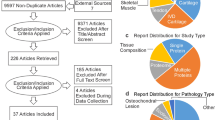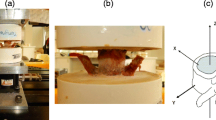Abstract
Idiopathic pes equinovarus is a congenital deformity of the foot and lower leg defined as a fixation of the foot in adduction, supination, and varus. Although the pathogenesis of clubfoot remains unclear, it has been suggested that fibroblasts and growth factors are involved. To directly analyze the protein composition of the extracellular matrix in contracted tissue of patients with clubfoot. A total of 13 infants with idiopathic clubfoot treated with the Ponseti method were included in the present study. Tissue samples were obtained from patients undergoing surgery for relapsed clubfeet. Contracted tissues were obtained from the medial aspect of the talonavicular joint. Protein was extracted after digestion and delipidation using zip-tip C18. Individual collagenous fractions were detected using a chemiluminescent assay. Amino acid analysis of tissue samples revealed a predominance of collagens, namely collagen types I, III, and VI. The high content of glycine and h-proline suggests a predominance of collagens I and III. A total of 19 extracellular matrix proteins were identified. The major result of the present study was the observation that the extracellular matrix in clubfoot is composed of an additional 16 proteins, including collagens V, VI, and XII, as well as the previously described collagen types I and III and transforming growth factor β. The characterization of the general protein composition of the extracellular matrix in various regions of clubfoot may help in understanding the pathogenesis of this anomaly and, thus, contribute to the development of more efficacious therapeutic approaches.

Similar content being viewed by others
References
Wynne-Davies R (1972) Genetic and environmental factors in the etiology of talipes equinovarus. Clin Orthop Relat Res 84:9–13
Dobbs MB, Gurnett CA (2009) Update on clubfoot: etiology and treatment. Clin Orthop Relat Res 467:146–153
Ponseti IV (1992) Treatment of congenital club foot. J Bone Joint Surg Am 74:448–454
Diméglio A, Bonnet F, Mazeau P et al (1996) Orthopaedic treatment and passive motion machine: consequences for the surgical treatment of clubfoot. J Pediatr Orthop B 3:173–180
Ponseti IV, Smoley EN (1963) Congenital club foot: results of treatment. J Bone Joint Surg Am 45:261–266
Ošťádal M, Chomiak J, Dungl P et al (2013) Comparison of the short-term and long-term results of the Ponseti method in the treatment of idiopathic pes equinovarus. Int Orthop 37:1821–1825
Irani RN, Sherman MS (1972) The pathological anatomy of idiopathic clubfoot. Clin Orthop Relat Res 84:14–20
Dunn PM (1972) Congenital postural deformities: perinatal associations. Proc R Soc Med 65:735–738
Bonnell J, Cruess RL (1969) Anomalous insertion of the soleus muscle as a cause of fixed equinus deformity. A case report. J Bone Joint Surg Am 51:999–1000
Gurnett CA, Boehm S, Connolly A et al (2008) Impact of congenital talipes equinovarus etiology on treatment outcomes. Dev Med Child Neurol 50:498–502
Lochmiller C, Johnston D, Scott A, Risman M et al (1998) Genetic epidemiology study of idiopathic talipes equinovarus. Am J Med Genet 79:90–96
Alvarado DM, Aferol H, McCall K et al (2010) Familial isolated clubfoot is associated with recurrent chromosome 17q23. 1q23. 2 microduplications containing TBX4. Am J Hum Genet 87:154–160
Sano H, Uhthoff HK, Jarvis JG et al (1998) Pathogenesis of soft-tissue contracture in club foot. J Bone Joint Surg Br 80:641–644
Fukuhara K, Schollmeier G, Uhthoff HK (1994) The pathogenesis of club foot. A histomorphometric and immunohistochemical study of fetuses. J Bone Joint Surg Br 76:450–457
Gilbert JA, Roach HI, Clarke NM (2001) Histological abnormalities of the calcaneum in congenital talipes equinovarus. J Orthop Sci 6:519–526
Li C, Nguyen Q, Cole WG, Alman BA (2001) Potential treatment for clubfeet based on growth factor blockade. J Pediatr Orthop 21:372–377
Cheon SS, Nadesan P, Poon R et al (2004) Growth factors regulate beta-catenin-mediated TCF-dependent transcriptional activation in fibroblasts during the proliferative phase of wound healing. Exp Cell Res 293:267–274
Poon R, Li C, Alman BA (2009) Beta-catenin mediates soft tissue contracture in clubfoot. Clin Orthop Relat Res 467:1180–1185
Ponseti IV (1996) Congenital clubfoot: fundamentals of treatment. Oxford University Press, Oxford
Mikesh LM, Aramadhaka LR, Moskaluk C et al (2013) Proteomic anatomy of human skin. J Proteomics 84:190–200
Gordon MK, Hahn RA (2010) Collagens. Cell Tissue Res 339:247–257
Nimni ME (1983) Collagen: structure, function, and metabolism in normal and fibrotic tissues. Semin Arthritis Rheum 13:1–86
Gay S, Rhodes RK, Gay RE, Miller EJ (1981) Collagen molecules comprised of alpha 1(V)-chains (B-chains): an apparent localization in the exocytoskeleton. Coll Relat Res 1:53–58
Chen W, Rock JB, Yearsley MM (2014) Different collagen types show distinct rates of increase from early to late stages of hepatitis C-related liver fibrosis. Hum Pathol 45:160–165
Sabatelli P, Palma E, Angelin A et al (2012) Critical evaluation of the use of cell cultures for inclusion in clinical trials of patients affected by collagen VI myopathies. J Cell Physiol 227:2927–2935
Sabatelli P, Gualandi F, Gara SK et al (2012) Expression of collagen VI α5 and α6 chains in human muscle and in Duchenne muscular dystrophy-related muscle fibrosis. Matrix Biol 31:187–196
Groulx JF, Gagné D, Benoit YD et al (2011) Collagen VI isa basement membrane component that regulates epithelial cell-fibronectin interactions. Matrix Biol 30:195–206
Lampe AK, Bushby KM (2005) Collagen VI related muscle disorders. J Med Genet 42:673–685
Kim J, Jimenez-Mallebrera C, Foley AR et al (2012) Flow cytometry analysis: a quantitative method for collagen VI deficiency screening. Neuromuscul Disord 22:139–148
Grumati P, Coletto L, Sandri M, Bonaldo P (2011) Autophagy induction rescues muscular dystrophy. Autophagy 7:426–428
Massoudi D, Malecaze F, Soler V et al (2012) NC1 long and NC3 short splice variants of type XII collagen are overexpressed during corneal scarring. Invest Ophthalmol Vis Sci 53:7246–7256
Genovese F, Barascuk N, Larsen L et al (2013) Biglycan fragmentation in pathologies associated with extracellular matrix remodeling by matrix metalloproteinases. Fibrogenesis Tissue Repair 6:9
Barallobre-Barreiro J, Didangelos A, Schoendube FA et al (2012) Proteomics analysis of cardiac extracellular matrix remodeling in a porcine model of ischemia/reperfusion injury. Circulation 125:789–802
Kampmann A, Fernández B, Deindl E et al (2009) The proteoglycan osteoglycin/mimecan is correlated with arteriogenesis. Mol Cell Biochem 322:15–23
Wang P, Zhou S, Xu L (2013) Hydrogen peroxide-mediated oxidative stress and collagen synthesis in cardiac fibroblasts: blockade by tanshinone IIA. J Ethnopharmacol 145:152–161
Mormone E, Yongke Lu, Ge Xiaodong et al (2012) Fibromodulin, an oxidative stress-sensitive proteoglycan, regulates the fibrogenic response to liver injury in mice. Gastroenterology 142:612–621
Liu XJ, Kong FZ, Wang YH et al (2013) Lumican accelerates wound healing by enhancing α2β1 integrin-mediated fibroblast contractility. PLoS ONE 8:e67124
Foot JS, Yow TT, Schilter H et al (2013) PXS-4681A, a potent and selective mechanism-based inhibitor of SSAO/VAP-1 with anti-inflammatory effects in vivo. J Pharmacol Exp Ther 347:365–374
Carrino DA, Mesiano S, Barker NM et al (2012) Proteoglycans of uterine fibroids and keloid scars: similarity in their proteoglycan composition. Biochem J 443:361–368
Jing L, Zhou LJ, Zhang FM et al (2011) Tenascin-x facilitates myocardial fibrosis and cardiac remodeling through transforming growth factor-β1 and peroxisome proliferator-activated receptor γ in alcoholic cardiomyopathy. Chin Med J 124:390–395
Lee CJ, Subeq YM, Lee RP et al (2014) Calcitriol decreases TGF-β1 and angiotensin II production and protects against chlorhexide digluconate-induced liver peritoneal fibrosis in rats. Cytokine 65:105–118
Zhao S, Wu H, Xia W et al (2013) Periostin expression is upregulated and associated with myocardial fibrosis in human failing hearts. J Cardiol 63:373–378
Tomasek JJ, Gabbiani G, Hinz B et al (2002) Myofibroblasts and mechano-regulation of connective tissue remodelling. Nat Rev Mol Cell Biol 3:349–363
Wakatsuki T, Kolodney MS, Zahalak GI et al (2000) Cell mechanics studied by a reconstituted model tissue. Biophys J 79:2353–2368
Author information
Authors and Affiliations
Corresponding author
Rights and permissions
About this article
Cite this article
Ošt’ádal, M., Eckhardt, A., Herget, J. et al. Proteomic analysis of the extracellular matrix in idiopathic pes equinovarus . Mol Cell Biochem 401, 133–139 (2015). https://doi.org/10.1007/s11010-014-2300-3
Received:
Accepted:
Published:
Issue Date:
DOI: https://doi.org/10.1007/s11010-014-2300-3




